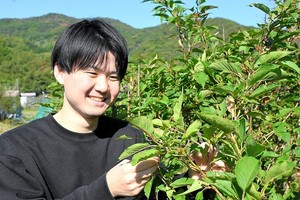By YUKIKO NAGATOMI/ Staff Writer
May 6, 2021 at 18:18 JST
OSAKA--Breeding staff at the Osaka Aquarium Kaiyukan here have been working around the clock to make sure a ringed seal pup that looked like he was going to die at birth bulks up.
The male pup, born at the aquarium in the city’s Minato Ward at 2:58 a.m. on April 1, appeared lifeless, barely moving immediately after birth.
The 55-centimeter-long, 2.5-kilogram pup also showed signs of hypothermia and hypoglycemia.
But thanks to the breeding staff who have worked tirelessly to give the pup treatment while the facility is shut down due to the novel coronavirus pandemic, he is now thriving and will hopefully make an appearance at the aquarium in the not-so-distant future.
His mother, Arare, estimated to be 16 years old, is a big hit with visitors. A cushion that features her appearance is a hot item at the aquarium’s gift shop.
His father, Moya, is estimated to be 13 or 14 years old.
Seeing their baby at birth, Satoshi Takeuchi, who has taken care of seals at the aquarium for about 10 years, thought, “I fear he's going to die.”
Veterinarians and breeding staff rushed to save the seal, administering medical treatment and staying constantly at his side until he was in stable condition.
When the seal's condition improved, “I was so happy that I cried,” Takeuchi said.
Because the pup's recovery took time, he could not be put in the same tank with his parents.
Instead, aquarium staff started bottle-feeding him.
About 20 breeding staff in rotation have observed the pup for 24 hours so that they can notice any abnormal change in his condition.
Bottle-feeding ringed seals is not a common practice at aquariums anywhere in the world, and though the aquarium had bottle-fed a spotted seal before, it was a first for Kaiyukan to do so with a ringed seal.
Takeuchi and fellow staff also searched records and sought advice from other aquariums that have successfully conducted artificial breeding of ringed seals, which informed them how a ringed seal pup increases its body weight and when it starts eating fish.
The pup is now full of energy, Takeuchi said. He weighed about 5.5 kilograms as of April 30, more than double his birth weight.
When hungry, the pup cries, “hoon, hoon,” and sleeps well after chugging a hearty meal of milk for marine mammals.
Starting in late April, he was taken off a 24-hour watch.
Still, staff stay all night at the aquarium to feed him milk every three to four hours.
Under the state of emergency over the novel coronavirus, the aquarium has been shut down since April 25, missing out on the crowds that typically visit during the Golden Week holidays.
Staff have yet to decide the pup’s name and the timing of his “debut” to the public but Takeuchi hopes the pup will eventually live in the same tank with his mother.
“Times are tough,” he said. “But we will carefully nurture him, hoping that (people) will come to meet him one day.”




















A peek through the music industry’s curtain at the producers who harnessed social media to help their idols go global.
A series based on diplomatic documents declassified by Japan’s Foreign Ministry
Here is a collection of first-hand accounts by “hibakusha” atomic bomb survivors.
Cooking experts, chefs and others involved in the field of food introduce their special recipes intertwined with their paths in life.
A series about Japanese-Americans and their memories of World War II